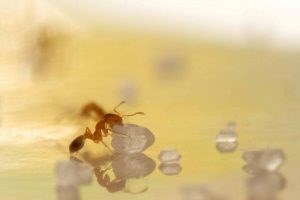This content was originally published by the Longmont Observer and is licensed under a Creative Commons license.
You walk into your kitchen and see a strange sight. Many small insects crawling in a line across your counter. You realize you have sugar ants and are wondering what to do about it. And for that matter, what are sugar ants? Sugar ants are actually a species of ant native to Australia that are not found here. The title “sugar ant” as it is used here is actually a colloquialism that refers to several different species of ant that are attracted to sweet things. The tiny ants you see in your kitchen could be one of these species, but the most common is the pharaoh ant.
Pharaoh ants are very small in size, about 2 mm in length, which is less than the tip of a ballpoint pen. They are light yellow to brown in color with a darker colored abdomen and almost transparent. They do have a stinger, which is only used to produce pheromones. Although pharaoh ants have compound eyes, they have very poor eyesight.
Each colony has multiple queens that lay eggs that hatch within five to seven days. It takes between 38 and 45 days for an ant to go from an egg to sexual maturity. Maturation is dependent on both temperature and relative humidity. Breeding occurs all year, but sexually reproductive ants are only produced twice per year. Each colony also contains winged males and worker ants.
Formation of new colonies occurs by a process called “budding,” which is when a few queens, workers, and part of the brood (eggs, larvae, and pupae) leave the colony for a new nest site. Although pharaoh ants prefer a familiar site for the new nest, they will choose a better site if one exists. The ants appear to have a minimum colony size they prefer. You might expect the new colony to compete with the old colony, but instead the two colonies cooperate to find food.
Pharaoh ants have three types of pheromones. One is used to build a trail and can last up to several days. The second type of pheromone is used to mark food sources and decays quickly, usually within a matter of minutes. This is because food sources change often and the ants must be able to take advantage of food sources when they find them. The final pheromone is actually a repellent and was first discovered in pharaoh ants. This pheromone warns other ants away from an area that contains danger or no food sources. It can be detected from a little over an inch away but decays within a couple of hours. The negative pheromone is often used at the forks in trails that were laid using the attractant pheromone. Because of the use of the three pheromone types, pharaoh ants are particularly good at finding food.

Pharaoh ants will scout for food and after they find a source, they return to the nest. Other ants will then follow the scout’s trail back to the food source. Pharaoh ants show a preference for foraging outside. If pharaoh ants venture indoors to forage they will often stay close to windows. When scouts return to the nest with food, the queen will often beg for some. If there is ample food available, the scout will likely give some to the queen. If food is scarce the scout will refuse to give the queen food and may even run away.
Scouts are thought to use a combination of pheromones and visual cues to help them remember where the nest is located. Scientists have discovered that forks in ant trails are at a 50 to 60 degree angles. When a scout reaches a fork, it will take the path that deviates the least from the direction it is currently going. In an experiment, researchers found that changing the fork angle to 60 to 120 degrees resulted in fewer scouts being able to locate the nest.
In addition to calling an exterminator or using ant bait to get rid of your "sugar ants", there are some things you can do to reduce the likelihood you will be invaded. Keeping floors and surfaces clean and wiping up spills immediately will go a long way to discouraging the ants. Keep your sink clean and dry. If you are going to leave dishes in the sink overnight, make sure you rinse them free of food. The sink and counters can be wiped down with bleach to get rid of any strong food odors that might attract ants. Bleach can also be used to break down the pheromones ants use. Take trash out regularly as well.
There are some home remedies that can be used, if you do not want to use chemicals in your home. Efficiency may vary, however. A solution of vinegar and water can be sprayed onto counter-tops, floors, and window panes to discourage ants. Black pepper can be spread around ant trails and in the corners. A homemade ant trap can be made using a box with two or three holes in it. Bait it with maple syrup or peanut butter and leave it out for two or three hours. Or you can mix borax, which is poisonous to pharaoh ants, with a sweet food source and leave it out. This may enable you to get rid of the entire colony. Whole cloves can be put around entrances to repel ants. Another repellent can be made from mixing lemon juice with water in a ratio of 1:3 or by boiling lemon peels in water for 10-15 minutes. This solution can be sprayed on affected areas. For more solutions you can search the internet or follow this home remedies link to learn more.
Whether you despise them or tolerate them, pharaoh ants are amazing creatures. You may even come to begrudgingly admire them!


